Bommes, Gironde, Nouvelle-Aquitaine 作者: 来源: 发布时间:2021-04-06
I. Population and Area
Total Area: 5,8 km2 (2.24sq mi)
Population in 2017: 465
Population Density: 80/km2 (208/sq mi)
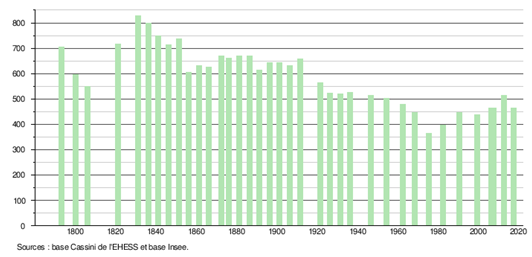
Histogram of demographic change
II. Natural Geography (environment and resources)
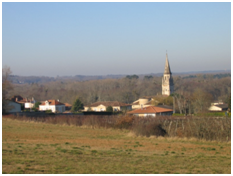
Bommes is a village in southern Gironde located in the heart of the Sauternes vineyard, and bordered to the west by the Ciron, a tributary of the Garonne.
The town is located 42 km south-east of Bordeaux, the capital of the department and 10 km west of Langon, the capital of the arrondissement and the canton.
The neighboring municipalities are Preignac to the northeast, Sauternes to the east and south, Budos to the southwest and Pujols-sur-Ciron to the northwest.
The municipal territory is essentially crossed, outside the village, by the departmental road D116 which leads to Landiras to the west and to Langon to the east; a network of smaller roads links the town and the place called Haut-Bommes to the surrounding villages.
The closest access to the A62 motorway (Bordeaux-Toulouse) is that of Exit 3 Langon, 9.5 km away by road to the east.
Access Exit 1 Bazas to the A65 motorway (Langon-Pau) is 19 km south-east.
The nearest SNCF train station is 6.5 km by road north-east from Preignac on the Bordeaux-Sète line of the TER Nouvelle-Aquitaine; that of Langon, offering more traffic, is 10 km to the east.
III. ECONOMY
Employment income (%): 76.9 (2016)
Average employment income of an average tax household (€):1 968net per month (23 616 net per year)(2014)

evolution of average tax revenue per household
Sources : http://www.journaldunet.com/business/salaire/bommes/ville-33060
https://insee.fr/fr/statistiques/2011101?geo=COM-33060#chiffre-cle-8
IV. Industrial Characterisitics
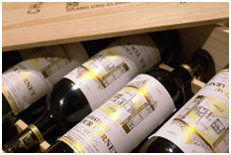
A large part of the municipal territory is devoted to viticulture and shelters some 70 vineyards for a vineyard with an area of 381 ha.
Six of these holdings are part of the official classification of Bordeaux wines of 1855 in the Sauternes appellation:
1. Clos Haut-Peyraguey :
Clos Haut-Peyraguey is a Premier Cru from Sauternes, whose 8 hectare estate is located in the center of the appellation, 40 km southeast of Bordeaux, at the highest point of the Plateau de la commune of Bommes, opposite the castle of Yquem. During the classification of 1855, it was part of the Château Peyraguey from which it was detached in 1879.
2. Chateau Lafaurie-Peyraguey :
Château Lafaurie-Peyraguey, is a 37 hectare wine estate in production located in the town of Bommes, in the Gironde department, in France.In AOC Sauternes, it is classified first grand cru in the official classification of Bordeaux wines of 1855.The owner has a Lalique hotel and restaurant, which obtained the five-star classification from Atout France on November 8, 2018.
With a yield of around 18 hl / ha depending on the vintage and a traditional aging of 18 to 20 months in barrels, the estate produces 30 to 40,000 bottles per year of Château Lafaurie-Peyraguey.
The estate also produces a second La Chapelle de Lafaurie-Peyraguey wine for 24,000 bottles per year. Since 2014 Château Lafaurie-Peyraguey also distributes two dry white wines "Grand Vin blanc Sec" and "Le Lys de Lafaurie-Peyraguey" of 10,000 bottles each.
2018 turnover € 1,625,442.
3. Château Rabaud-Promis :
Château Rabaud-Promis is a wine estate located in Bommes in Gironde. In AOC Sauternes, it is classified first grand cru in the official classification of Bordeaux wines of 1855.
4. Rayne-Vigneau Castle :
The surface of the vineyard covers 84 hectares, the planting consists of Sémillion (74%), Sauvignon Blanc (24%) and Muscadelle (2%). The average age of the vines is 30 years.
The terroir is made up of sandy gravel composed of precious stones, limestones on a clay subsoil.
5. Château Sigalas-Rabaud :
Sigalas-Rabaud has 14.25 hectares of vines, planted with 85% Sémillon and 14% Sauvignon and the rest of Muscadelle. The average yield is 17 hectoliters per hectare.
6. Chateau La Tour Blanche :
Château La Tour Blanche, is a vineyard of the Sauternes appellation in the Bordeaux vineyard covering 70 hectares, of which 40 ha are planted with vines. It produces a sweet wine. It was ranked at the top of the Sauternes Premiers Crus during the official classification of Bordeaux wines in 1855.
V. Attractions
Château de Rayne-Vigneau (Rayne-Vigneau Castle)
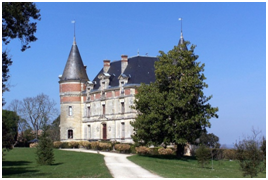
The area is located in the south-eastern part of the town, near the gap called Le Haut-Bommes and access is from the departmental road D125e1 which leads to Sauternes to the south and to Pujols-sur-Ciron North.
The 17th century castle and the Vigneau estate belong successively to the families ofVigneau, Sauvage and Duffour, and at the beginning of the 19th century to Joseph-Marie Dert who sold it in 1834 tothe Baroness of Rayne, née Catherine de Pontac. His nephew Gabriel, viscount of Pontac, inherits it.Without children, he bequeathed it in 1892 to his nephew Albert, viscount ofPontac, who is JérômeVinotPréfontaine's quarter ancestor, thecurrent owner. The castle was rebuilt in 1865 by Gabriel dePontac, from plans by Michel-Louis Garros. The new buildingis built on the foundations of the old castle which it included in part.The main building is flanked by two towers, a chapel with semicircular apses isleaning against one of them. The set is Napoleon III style while the interior is rather XVIII thcentury. The very tall house has two floors to the south and three on the north side. The basementincludes kitchens, cellars and vaulted outbuildings; the ground floor is the floor dreception with in particular a hall which represents the central part of the house and which has thepeculiarity of being decorated with decorative coats of arms. The two floors house thebedrooms and,in one of the towers, a library whose furniture follows the circular shape of the room.
The Rayne-Vigneau castle, as well as its park and facilities, was listed as a historic monument in 2004. The castle, built in 1379, was replaced in the 19th century by Michel Garros. Mr. de Roton, co-owner, discovered in 1925 many so-called precious stones in his vines (agates, jasper, onyx). This collection contains 12,000 pieces, of which 2,000 are cut. They come from fossil oysters found in a marly bank barely 200 meters long and 10 to 20 meters wide.
The castle and its park with its facilities are the subject of a classification as Historic Monuments by decree of April 19, 2004.
In 2015, the estate was bought by the Trésor du Patrimoine group.
2. L'église Saint-Martin(Saint Martin's church)
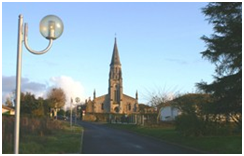
The church was rebuilt in 1840 because it was considered dangerous. The bell tower is rebuilt under Napoleon III, after a donation from the Viscount of Pontac. In thanks, the town had his arms and those of his wife sculpted on the building. The Count is still generous with the restoration of the stained glass windows. One of them is surmounted by a design on the bottom of a red mouth with stars which recalls the arms of Pontac.
The Saint-Martin church was rebuilt in the 19th century from the old Romanesque church of the 12th century: it had a flat bell tower (gable) which was replaced in 1878 by a pointed bell tower, according to the will of Cardinal Donnet.
Inside there is a statue of Saint Benedict from the 17th century as well as an 18th century pulpit and the coats of arms of the families of Pontac and Mauvezin. The four capitals of the old church are placed on the perimeter wall of the presbytery: one represents a basket, the other of the doves facing each other carrying on the side a kind of wheel decorated with rosette and drinking from a chalice under a palm.
CONTACT
Phone. : +33 5 56 63 68 00
33210 BOMMES
GPS (Latitude): 44.5467 / GPS (Longitude): -0.3573
WEBSITE :www.sauternais-graves-langon.com
3. Château Lafaurie-Peyraguey (Chateau Lafaurie-Peyraguey)
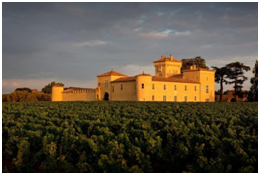
The origin of the castle dates back to the 13th century, but the first proven owner is Raymond Peyraguey who moved to Bommes in 1618. He developed the vineyard to produce very simple sweet wines appreciated in the 17th century. The domain was bought in 1742 by Baron Pierre de Pichard, member of the Parliament of Bordeaux, and then owner of the wine estates of Château Lafite in Pauillac and Château Coutet in Barsac. It is he who really develops the exploitation, as much from the point of view of the surface of the vineyard (30 ha) as of the techniques and the volume of production. Baron de Pichard was guillotined in 1794 and the estate was put up for sale by the Republic. It is bought by Lafaurie, living in Preignac, which, in about thirty years, gives great renown to the quality and image of Peyraguey wine. In 1855, he received the consecration by becoming one of the first grands crus of the official classification of Bordeaux wines.
In 1865, the widow of Lafaurie sold the estate to Count Duchâtel, owner of Château Lagrange. He modernized the operation and restored the château, but the château passed from hand to hand until 1917. On that date, DésiréCordier, a merchant from Lorraine, acquired it, as well as estates in the Médoc such as Château Gruaud-Larose and Château Talbot, and established itself as one of the largest wine merchants on the Place de Bordeaux for almost 70 years. In 1984, the estate, like the entire Cordier group, became the property of the Suez group.
In February 2014 Silvio Denz, president of CristallerieLalique, and Château Faugères and Château Péby-Faugères, two great classified growths of Saint Emilion, bought the estate.
Visits & Tasting
At the heart of Sauternes, visit Château Lafaurie-Peyraguey, property of 36 hectares, the “enclos”, historical terroir of its grand vin, Premier Grand Cru Classé, the cellars and the Chapel, entirely decorated by Lalique.
Visits by appointment only from Monday to Sunday from 10am to 6pm. For any request, please contact us at visite@lafauriepeyragueylalique.com or call at +33 (0) 5.24.22.80.11
4. Classic Tour
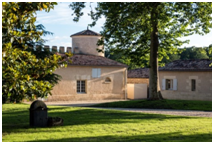
During this visit, you discover the history of Château Lafaurie-Peyraguey, the territory of Sauternes, its viticulture and the secret of its sweet wines. We explain the special link that unites our wines to the art of LALIQUE. After the visit of the estate, historical plot l'Enclos, fermentating room, cellars and the Chapel, we invite you to taste three wines of the Château. This tasting moment takes place at the Vinothèque or in the Chapel, nestled between the two historic wine cellars.
20 € per person
5. Visit & Vertical Tasting
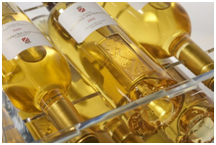
After a visit of the estate, the vat room, the cellars and the chapel, let your senses go for a vertical tasting of four vintages of our first Grand Cru Classé in Sauternes. This experience will open your taste buds to the magic of Sauternes and reveal what makes a vintage a great emotion over the years.
35 € per person
6. Wine & Food Pairing Visit by Michel starred Chef Jérôme Schilling
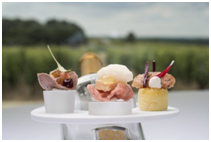
Discover unique wine and food pairings! After discovering the property, you will enjoy a special moment. Bites prepared by the Michelin-starred chef of LALIQUE Restaurant, Jérôme Schilling, will be served with three wines during. Sauternes will reveal new secrets and beautiful emotions.
40 € per person
Sources :http://bommes.fr/upload/1_village/patrimoine/chateaux.pdf
http://www.bordeaux-graves-sauternes.com/fr/4-patrimoine/27-eglises/207-eglise-saint-martin-de-bommes/
https://www.lafauriepeyragueylalique.com/en/wine-tourism/visits-tasting/
VI. History
There would be prehistoric caves on the edge of the Ciron.
The place called "Red Houses" would be a stopover on a Roman road.
In the 10th century, the Benedictines owned a priory, on the site of the presbytery, which depended on La Sauve.
On April 22, 1288, the King of England allowed Jean Colomb, bourgeois of Bordeaux, to build a strong house.
In 1310 the Antonins owned the Vigard (or Bigard) hospital with chapel which depended on the Commandery of Aubeterre (Charente), then moved on to the Feuillants (order of Citeaux) in 1625. The whole town belonged to the religious.
The Benedictines were the first to plant vines and, above all, to cultivate concentrated grapes in France (noble rot), a method adopted by the Antonins a few centuries later.
We find the trace of the chapel "St Antoine de Vigard" in 1310; a marriage and a baptism are celebrated there in 1608 and that same year she receives the visit of the cardinal of Sourdis. This chapel has an ogival portal and a square tower. Nowadays, only part of the vault remains. The letter T is the signature of the Antonines.
The same authorreported:
a 15th century winemaker's house.
a lordship in the sixteenth century.
The situation of the town in the 18th century is described in the work of Jacques Baurein.
Vine growing is done in jououles, that is to say that they are "interspersed with a certain number of earthen crops, which are sown in rye, or some other species of grain". There are serious ones, some of which are quite good, and others of a very inferior quality.
The pastures and meadows are numerous but exposed to the overflows of the Ciron.
The parish is placed in the jurisdiction of the Royal Provost of Barsac.
There were approximately 199 fires, representing 994 residents.
The Augeys mill is located on the banks of the Ciron.
The distribution of sizes between the upper part and the lower part was disputed:
"The King being informed that the Parish of Bommes was composed of two separate parts, one of which is called the top, and the other the bottom Bommes, which had previously been united in the same collection, but that the number of those entered in the Collectors table was much more considerable in the upper part, the distributions were commonly made to the disadvantage of taxpayers in the lower part, who would like to form a particular collection in the future, so that their contribution was settled with more proportion and fairness. (Consequently), the King, by Decree of his Council of State, held in Versailles, on September 31, 1766, ordered that the lower part of Bommes be disunited from the upper, with respect to Taxes of all kinds. "
During the Revolution, the parish of Saint-Martin de Bommes formed the town of Bommes.
VII. Other information
A large part of the municipal territory is devoted to viticulture and shelters some 70 vineyards for a vineyard with an area of 381 ha.
VIII. Contact information
Bommestown hall address :
Bommes town hall
4 le Bourg
33210 Bommes
Opening Hours of the town hall:
Thursday: 8 a.m. to 12 p.m. and 2 p.m. to 6 p.m.
Monday: from 2 p.m. to 6 p.m.
Friday: from 8 a.m. to 12 p.m.
Wednesday: from 8 a.m. to 12 p.m.
Tuesday: 8 a.m. to 12 p.m. and 2 p.m. to 6 p.m.
Mayor :Bernard Laurans (Mandate : 2014-2020)
Phone number: 05 56 76 60 68
Fax: 05 56 76 21 25
Mail: bommes@laposte.net
Website :http://bommes.fr
Sources :http://www.cartesfrance.fr/carte-france-ville/33060_Bommes.html#mairie
